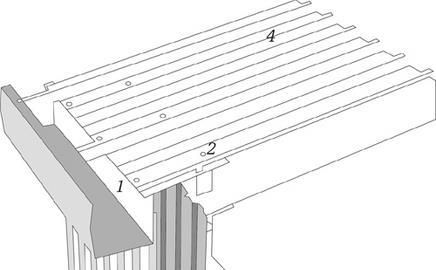Corrugated steel sheets are more sophisticated than ever, and used in everything from schools and museums to hospitals. But Peter Mayer of ║├╔ź¤╚╔˙TV LifePlans discovers things can go wrong
Corrugated steel sheets have come a long way from covering barns and sheds. Now called profiled (low-carbon) steel cladding, they grace everything from hospitals and museums to schools, retail units and the ubiquitous warehouses.
Guidance on design is provided by BS 5427-1:1996 ÔÇô the code of practice for profiled sheet cladding on buildings. The Metal Cladding and Roofing Manufacturers Association and National Federation of Roofing Contractors also provide good practice documents.
However, despite advancements, profiled sheets arenÔÇÖt without their problems. Here are some of the more common complaints.
1. Cut-edge exposure
The trouble with steel is it corrodes in the presence of oxygen, a process which is accelerated with the addition of water and pollutants. This combination describes most external environments in the UK.
To counter steel corrosion, manufacturers of steel sheets apply a corrosion-protection layer such as hot-dip zinc galvanising or zincÔÇôaluminium alloy. If required, an additional decorative organic coating such as PVC also enhances the corrosion protection.
However, the resulting coils of carefully protected steel sheets, which are hundreds of metres in length, are then cut into manageable lengths, exposing unprotected steel at the cut ends. For an initial period the exposed steel edges are protected by the zinc layer which corrodes ÔÇťsacrificiallyÔÇŁ for the steel. In the long term, cut-edge corrosion is unavoidable.
The risk of premature edge corrosion can be reduced by specifying sheeting which is manufactured to minimise edge corrosion risk. For example, sheets with zincÔÇôaluminium alloy have lower rates of sacrificial corrosion, and steel would last longer than those with pure zinc coating.
Painting the cut edges and periodic re-painting where access is possible may provide a solution. If sheets with corroded edges are not repaired or replaced, further damage to the sheet may result, with increased risk of water penetration. Delamination of decorative coating may also be associated with cut-edge corrosion.
2. Fixings: corrosion and leaking
Steel cladding sheets need to be secured in place. Through-fixing may appear to be a straightforward fixing method but it creates a hole in the sheet, in effect compromising water and air permeability resistance.
Self-drilling and tapping screws with integral washers are normally used to maintain weathertightness. The best-performing washers are made of EPDM and the thickness and material hardness should be specified for the application.
Fasteners should be selected with durability similar to the expected life of the sheeting. Typically, this means austenitic stainless steel fasteners grade 1.4301 to BS 10088 (UK type 304) for more than 25 year life in urban or polluted environments. Special precautions may be necessary in coastal environments.
Where different metals are in contact, bimetallic corrosion may take place. Leaks may occur if corrosion takes place, the fasteners have been over or under-tightened or fixed crookedly, washers deteriorate, and fixings have insufficient pull-out resistance.
3. Condensation: water damage
Condensation can result in moisture accumulation with associated deterioration from corrosion and mould growth, as well as reduced thermal efficiency. The investigation of surface or interstitial condensation to enable successful remedial measures to be designed may take time. Monitoring may be required. The element may need to be opened up to establish the actual construction and processes at work. Investigations should also provide information to enable a remedial solution to be proposed to minimise thermal bridges as well as the risk of surface condensation or interstitial condensation.
The code of practice for condensation control, BS 5250, refers to BS EN ISO 6946 and 13788 for calculation methods to model thermal transmittance and condensation risk.
Condensation on the underside of sheets may exacerbate cut-edge and fastener corrosion.
4. Expansion and contraction
Distortion, warping or buckling of sheets and around fixings may be the result of thermal movement. Dark coloured sheeting above a layer of insulation is most at risk. Cladding surface temperature may increase by 75┬░C in a 24-hr period, causing nearly 5.5mm expansion for a 6m-long sheet. A surface temperature decrease of 50┬░C would result in a 6m sheet contracting 3.6mm. Allowance for this scale of expansion and contraction around fixings is critical in avoiding this defect.
Postscript
BLP provides building latent defect insurance and New Homes Warranties for dwellings
Specifier 04 July 2008
- 1
- 2
- 3
- 4
 Currently reading
Currently readingCauses of failure: Profiled sheeting
- 5
- 6
- 7
- 8
- 9
- 10
- 11

































No comments yet